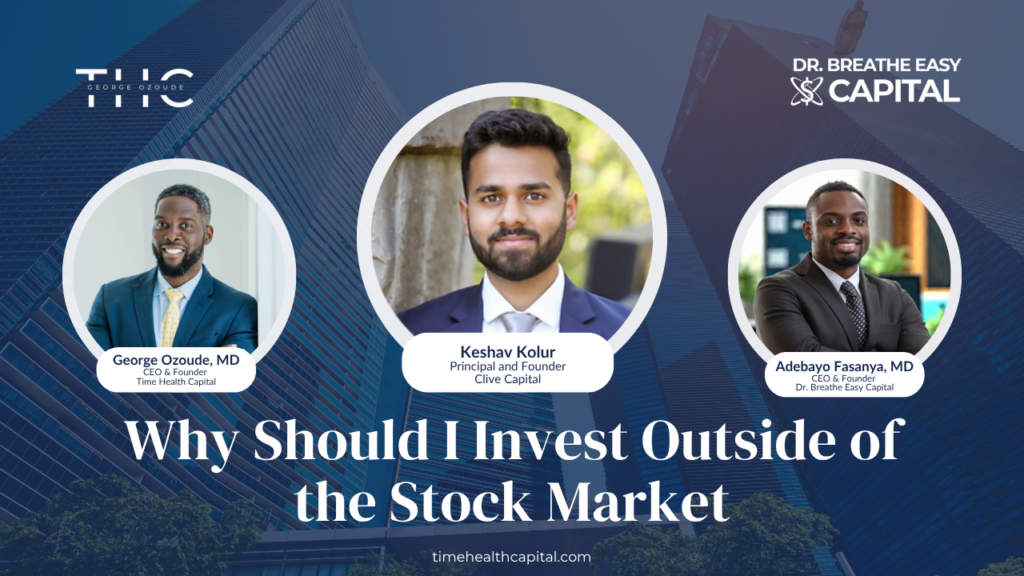
While the stock market remains a staple for wealth-building, a growing number of high-income professionals—including physicians—are exploring alternative investment paths.
In a webinar hosted by George Ozoude, MD, CEO of Time Health Capital, and Adebayo Fasanya, MD, CEO of Dr. Breathe Easy Capital, guest expert Keshav Kolur, founder of Clive Capital, shared why he and his team focus on real estate, energy, small businesses, and private credit as a more diversified and resilient financial strategy.
Why Move Beyond the Stock Market?
Keshav revealed that although the stock market averages 8–10% annual returns, it’s often accompanied by high volatility. Large-scale global events or market swings can erode investor confidence overnight. As a shareholder, you’re also disconnected from decision-making and must rely on quarterly reports and market sentiment.
In contrast, private assets like real estate and small businesses empower investors with:
-
Tangible cash flow and tax benefits
-
Greater transparency and control
-
Lower correlation with stock market fluctuations
The Benefits of Alternative Assets
Keshav highlighted several compelling advantages:
1. Tax Efficiency
Real estate offers depreciation and passive loss offsets; energy investments may include upfront depreciation; business ownership enables deductible expenses.
2. Better Cash Flow
Stock dividends typically yield 2–4%, whereas alternatives like real estate syndications or private credit can yield 8–20%+ annually, with regular cash distributions.
3. Control & Transparency
Private investments offer more visibility and interaction with asset managers. Investors can engage directly, not through intermediaries.
4. True Diversification
Different assets don’t move in lockstep. A downturn in equities doesn’t automatically diminish the value of rental homes, energy assets, or private businesses.
Recognizing & Managing Risk
Keshav made it clear that alternative assets carry unique risks, but said the key factor is “who you invest with.” Here’s his approach:
-
Vet your operator’s track record and communication style
-
Diversify across asset types, geography, and teams
-
Understand specific risks: drilling may fail; leverage may amplify losses
-
He delayed investing in oil and gas for a year—waiting for the right team to mitigate risk
Crafting a Balanced Portfolio
Keshav outlined an institutional-style portfolio strategy:
-
~40% in equities (mostly via tax-advantaged retirement accounts)
-
~40% in real estate & energy (syndications, deposits, private operators)
-
~20% in cash reserves and insurance vehicles
Over time, his plan is to shift toward income-generating alternatives—like debt, syndications, and energy—to balance growth and stability.
Spotlight: Build‑to‑Rent Communities
One of Clive Capital’s focus areas is Build-to-Rent (BTR) developments:
-
Composed of single-family homes built specifically for rental
-
Attract family renters seeking more space and community
-
Often offer lower turnover than traditional rentals
-
Easier property management in concentrated clusters
-
Attractive to institutional buyers for scale and stability
At present, Clive is developing 500+ homes in Lafayette, LA, leveraging local market dynamics and partnerships.
Final Thoughts
Keshav Kolur’s insights reinforce a broader trend: the stock market alone may not suffice for long-term wealth. By strategically incorporating real assets, energy, business, and credit investments, investors can access stronger cash flow, tax advantages, and real-world value.
Success requires education, due diligence, and diverse relationships, but the payoff can be meaningful—not just financially, but in time and autonomy.
Want to connect with our community for more educational opportunities?
📺 Watch the full webinar here, hosted by George Ozoude, MD and Adebayo Fasanya, MD, featuring guest expert Keshav Kolur of Clive Capital. Learn how to build a resilient portfolio beyond Wall Street.
